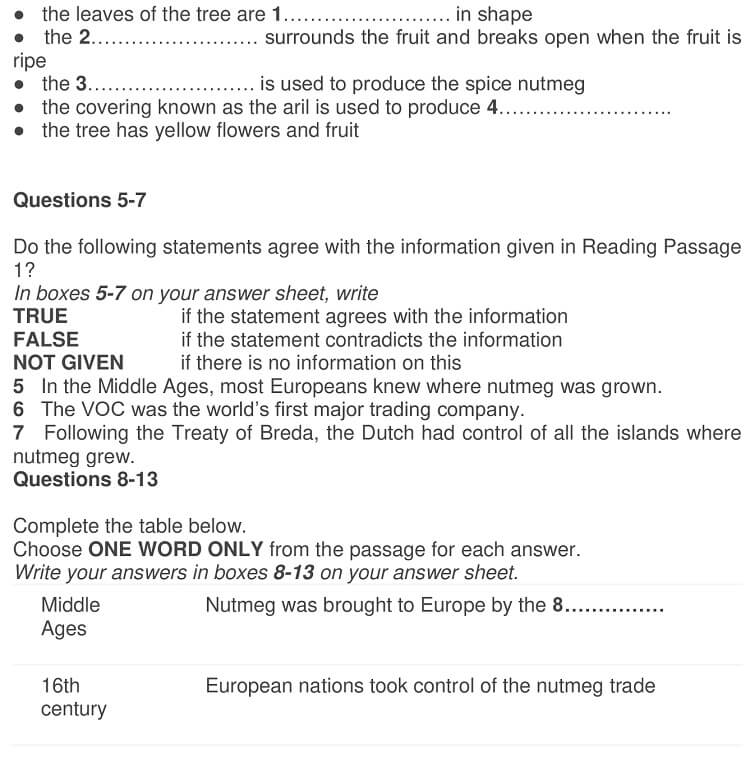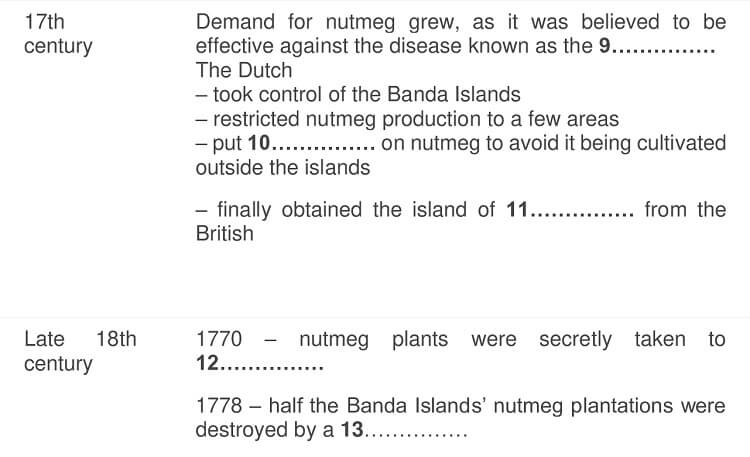Nutmeg a Valuable Spice Reading Answers
6 min read
Updated On
-
Copy link
Table of Contents

Limited-Time Offer : Access a FREE 10-Day IELTS Study Plan!
The Academic passage ‘Nutmeg – a valuable spice‘ is a reading passage that appeared in an IELTS Test. It contains some of the IELTS reading question types. If you are interested in familiarising yourself with all the question types, don’t hesitate to take an IELTS reading practice test.
The question types found in this passage are:
Note Completion: In these types of questions, you are required to complete the notes by following the passage. You have to locate the keywords from the passage, correlate the questions, and fill the gap with the most suitable answer. Questions could be paraphrased and they would not be necessarily taken from the passage.
True/False/Not given: In these types of questions, you have to write the best response as per the passage’s content in terms of true/false/not given. If you feel the question/sentence is correct with respect to the passage, write ‘True’ and if you think it is not valid, write ‘False’. However, if you feel the reference is nowhere to be mentioned, write ‘Not Given’.
Table Completion: In these types of questions, you are required to complete the table by following the passage. You have to locate the keywords from the passage, correlate the table’s content with the passage, and fill the gap with the most suitable answer. Questions could be paraphrased and they would not be necessarily taken from the passage.
Nutmeg – a valuable spice




Answers
1 Answer: Oval
Question Type: Note Completion
Answer location: Paragraph 1, Lines 4-5
Answer explanation: “The tree is thickly branched with dense foliage of tough, dark green oval leaves, and produces small, yellow, bell-shaped flowers and pale yellow pear-shaped fruits.” From this line, we can state that the shape of the leaves of the Nutmeg trees is oval.
2 Answer: husk
Question Type: Note Completion
Answer location: Paragraph 1, Lines 6-7
Answer explanation: “The fruit is encased in a flesh husk. When the fruit is ripe, this husk splits into two halves along a ridge running the length of the fruit.” In the first quoted sentence, ‘encased’ means ‘surrounded by’ and ‘splits’ means ‘to break open’. Hence, ‘husk’ is the answer.
3 Answer: seed
Question Type: Note Completion
Answer location: Paragraph 1, Lines 8-11
Answer explanation: “Inside is a purple-brown shiny seed, 2-3 cm long by about 2 cm across, surrounded by a lacy red or crimson covering called an ‘aril’. These are the sources of the two spices nutmeg and mace, the former being produced from the dried seed and the latter from the aril.” This explains that the aril is used to produce spices.
4 Answer: mace
Question Type: Note Completion
Answer location: Paragraph 1, Lines 9-11
Answer explanation: “These are the sources of the two spices nutmeg and mace, the former being produced from the dried seed and the latter from the aril.” This explains that the aril or the covering on the seed, that is marked by the word ‘latter’, is used to produce mace.
5 Answer: False
Question Type: True/false/not given
Answer location: Paragraph 2, Lines 3-6
Answer explanation: “Throughout this period, the Arabs were the exclusive importers of the spice to Europe. They sold nutmeg for high prices to merchants based in Venice, but they never revealed the exact location of the source of this extremely valuable commodity.” The word ‘period’ refers to the Middle Ages in the first sentence of the same paragraph and these quoted lines suggest that Europeans were not able to find the exact location of nutmegs.
6 Answer: Not Given
Question Type: True/false/not given
Answer location: No reference given.
Answer explanation: “In 1602, Dutch merchants founded the VOC, a trading corporation better known as the Dutch East India Company. By 1617, the VOC was the richest commercial operation in the world. The company had 50,000 employees worldwide, with a private army of 30,000 men and a fleet of 200 ships.” The only inference that can be made here is that the VOC was the richest commercial operation but we don’t get to know anything about it being the first major trading company in the world.
7 Answer: True
Question Type: True/false/not given
Answer location: Paragraph 5, Lines 13-20
Answer explanation: “After decades of fighting for control of this tiny island, the Dutch and British arrived at a compromise settlement, the Treaty of Breda, in 1667. Intent on securing their hold over every nutmeg-producing island, the Dutch offered a trade…The British agreed. That other island was Manhattan, which is how New Amsterdam became New York. The Dutch now had a monopoly over the nutmeg trade which would last for another century.” From this sentences we can confirm that after the Treaty of Breda was signed, the British handed over the islands grew to the Dutch who had a monopoly over the areas where Nutmegs grew.
8 Answer: Arabs
Question Type: Table Completion
Answer location: Paragraph 2, Lines 3
Answer explanation: “Throughout this period, the Arabs were the exclusive importers of the spice to Europe.” Therefore, during the Middle Ages, the Arabs exported spice to Europe.
9 Answer: Plague
Question Type: Table Completion
Answer location: Paragraph 4, Lines 4-7
Answer explanation: “At the same time, thousands of people across Europe were dying of the plague, a highly contagious and deadly disease. Doctors .. decided nutmeg held the cure.” This suggests the disease that was cured by nutmeg was plague.
10 Answer: Lime
Question Type: Table Completion
Answer location: Paragraph 5, Lines 9-11
Answer explanation: “In addition, all exported nutmeg was covered with lime to make sure there was no chance a fertile seed which could be grown elsewhere would leave the islands.” This shows that lime was put all over the nutmegs so that the seed losses its fertility and the Dutch could prevent it from being cultivated outside the islands.
11 Answer: Run
Question Type: Table Completion
Answer location: Paragraph 5, Lines 15-18
Answer explanation: “Intent on securing their hold over every nutmeg-producing island, the Dutch offered a trade: if the British would give them the island of Run, they would in turn give Britain a distant and much less valuable island in North America.” This showed how an Island called Run was obtained by Dutch from the British through the Treaty of Breda.
12 Answer: Mauritius
Question Type: Table Completion
Answer location: Paragraph 6, Lines 1-2
Answer explanation: “Then, in 1770, a Frenchman named Pierre Poivre successfully smuggled nutmeg plants to safety in Mauritius, an island off the coast of Africa.” This suggests the smuggling (secretly taken) of nutmegs to Mauritius by Pierre Poivre.
13 Answer: Tsunami
Question Type: Table Completion
Answer location: Paragraph 6, Lines 4-5
Answer explanation: “Next, in 1778, a volcanic eruption in the Banda region caused a tsunami that wiped out half the nutmeg groves.” This shows how the Tsunami caused by a volcanic eruption destroyed (‘wiped out’) the Banda Islands’ Nutmeg plantations.
Check More IELTS Reading Answers
Practice IELTS Reading based on question types

Start Preparing for IELTS: Get Your 10-Day Study Plan Today!
Recent Articles

Nehasri Ravishenbagam

Haniya Yashfeen

Haniya Yashfeen

Haniya Yashfeen




Post your Comments